Evaluation of Hybrid Fiber Multiscale Polymer Composites for Structural Confinement under Cyclic Axial Compressive Loading
Abstract
1. Introduction
2. Experimental Work
2.1. Materials Used
2.1.1. Concrete
2.1.2. MWCNT Modified Epoxy Resin
2.1.3. Fiber
2.2. FRP Composite Preparation
2.3. Preparation of Confined Specimen
2.4. Characterization Techniques
3. Results and Discussion
3.1. Group A Specimens
3.1.1. High-Resolution Transmission Electron Microscopy (HRTEM) of Epoxy Nanocomposites
3.1.2. Mechanical Properties of Epoxy Nano and Hybrid Composites
Tensile Properties
Fracture Toughness
Flexural Properties
3.2. Effect of FRP Confinement on Concrete—Group B Specimens
3.2.1. Axial Compressive Behavior
Unconfined Specimens
Epoxy-Based FRP Confined Specimens
MWCNT Incorporated Epoxy-Based FRP Confined Specimens
3.3. Efficiency of Wrapping in Concrete Columns
3.4. Stress–Strain Behavior
3.5. Mathematical Models
Ultimate Strength Models for FRP Confined Specimens
4. Conclusions and Future Outlook
- As evident from the test results under multiple load compression cycles, the load carrying capacity of the structures could be enhanced remarkably with FRP confinements. A noticeable additional improvement could also be accomplished with MWCNT modification of epoxy;
- The enhanced strength and ultimate strain by 60 to 75% of the confined specimens are found to be influenced by the type of FRP confinement and MWCNT modification of the epoxy matrix. Hybrid confinement was more effective than sisal FRP in terms of strength enhancement;
- When hybrid confinement is taken into consideration the outer FRP layers aided in resisting the axial compressive loads post ultimate loading and thereby resisting catastrophic failure in columns;
- MWCNT incorporated epoxy wrapped specimens were capable of giving early warning in the form of small cracking sounds as an indication of the formation of microcracks before ultimate failure;
- An empirical equation is developed to predict the peak compressive strength of FRP-confined concrete. The results of the proposed model and experimental results were found to be in good agreement.
Author Contributions
Funding
Data Availability Statement
Acknowledgments
Conflicts of Interest
References
- Padanattil, A.; Lakshmanan, M.; Jayanarayanan, K.; Mini, K.M. Strengthening of Plain Concrete Cylinders with Natural FRP Composite Systems. Iran. J. Sci. Technol. Trans. Civ. Eng. 2019, 43, 381–389. [Google Scholar] [CrossRef]
- Tang, Y.; Wang, Y.; Wu, D.; Liu, Z.; Zhang, H.; Zhu, M.; Chen, Z.; Sun, J.; Wang, X. An Experimental Investigation and Machine Learning-Based Prediction for Seismic Performance of Steel Tubular Column Filled with Recycled Aggregate Concrete. Rev. Adv. Mater. Sci. 2022, 61, 849–872. [Google Scholar] [CrossRef]
- Rousakis, T.C.; Karabinis, A.I.; Kiousis, P.D. FRP-Confined Concrete Members: Axial Compression Experiments and Plasticity Modelling. Eng. Struct. 2007, 29, 1343–1353. [Google Scholar] [CrossRef]
- Lam, L.; Teng, J.G. Stress–Strain Model for FRP-Confined Concrete under Cyclic Axial Compression. Eng. Struct. 2009, 31, 308–321. [Google Scholar] [CrossRef]
- Lam, L.; Teng, J.G.; Cheung, C.H.; Xiao, Y. FRP-Confined Concrete under Axial Cyclic Compression. Cem. Concr. Compos. 2006, 28, 949–958. [Google Scholar] [CrossRef]
- Pimanmas, A.; Hussain, Q.; Panyasirikhunawut, A.; Rattanapitikon, W. Axial Strength and Deformability of Concrete Confined with Natural Fibre Reinforced Polymers (NFRP). Mag. Concr. Res. 2017, 71, 55–70. [Google Scholar] [CrossRef]
- Li, P.; Wu, Y.-F. Stress–Strain Behavior of Actively and Passively Confined Concrete under Cyclic Axial Load. Compos. Struct. 2016, 149, 369–384. [Google Scholar] [CrossRef]
- Zeng, J.-J.; Ye, Y.-Y.; Guo, Y.-C.; Lv, J.-F.; Ouyang, Y.; Jiang, C. PET FRP-Concrete-High Strength Steel Hybrid Solid Columns with Strain-Hardening and Ductile Performance: Cyclic Axial Compressive Behavior. Compos. Part B Eng. 2020, 190, 107903. [Google Scholar] [CrossRef]
- Taghia, P.; Bakar, S.A. Mechanical behaviour of confined reinforced concrete-CFRP short column-based on finite element analysis. World Appl. Sci. J. 2013, 24, 960–970. [Google Scholar]
- Wu, H.-L.; Wang, Y.-F.; Yu, L.; Li, X.-R. Experimental and Computational Studies on High-Strength Concrete Circular Columns Confined by Aramid Fiber-Reinforced Polymer Sheets. J. Compos. Constr. 2009, 13, 125–134. [Google Scholar] [CrossRef]
- Tang, Y.; Fang, S.; Chen, J.; Ma, L.; Li, L.; Wu, X. Axial Compression Behavior of Recycled-Aggregate-Concrete-Filled GFRP–Steel Composite Tube Columns. Eng. Struct. 2020, 216, 110676. [Google Scholar] [CrossRef]
- Ozkilic, Y.O.; Gemi, L.; Madenci, E.; Aksoylu, C.; Kalkan, İ. Effect of the GFRP Wrapping on the Shear and Bending Behavior of RC Beams with GFRP Encasement. Steel Compos. Struct. 2022, 45, 193–204. [Google Scholar] [CrossRef]
- Madenci, E.; Özkılıç, Y.O.; Aksoylu, C.; Safonov, A. The Effects of Eccentric Web Openings on the Compressive Performance of Pultruded GFRP Boxes Wrapped with GFRP and CFRP Sheets. Polymers 2022, 14, 4567. [Google Scholar] [CrossRef] [PubMed]
- Choi, D.; Vachirapanyakun, S.; Kim, S.-Y.; Ha, S.-S. Ductile Fiber Wrapping for Seismic Retrofit of Reinforced Concrete Columns. J. Asian Concr. Fed. 2015, 1, 37–46. [Google Scholar] [CrossRef]
- Padanattil, A.; Karingamanna, J.; Mini, K.M. Novel Hybrid Composites Based on Glass and Sisal Fiber for Retrofitting of Reinforced Concrete Structures. Constr. Build. Mater. 2017, 133, 146–153. [Google Scholar] [CrossRef]
- Joseph, L.; Sarath Kumar, P.; Jayanarayanan, K.; Mini, K.M. Strengthening of Plain Concrete Cylinders with Hybrid Composites Based on Basalt and Sisal Fiber Systems. Mater. Today Proc. 2022, 66, 2444–2448. [Google Scholar] [CrossRef]
- Wahab, N.; Srinophakun, P.; Hussain, Q.; Chaimahawan, P. Performance of Concrete Confined with a Jute–Polyester Hybrid Fiber Reinforced Polymer Composite: A Novel Strengthening Technique. Fibers 2019, 7, 72. [Google Scholar] [CrossRef]
- Ramesh, M.; Palanikumar, K.; Reddy, K.H. Mechanical Property Evaluation of Sisal–Jute–Glass Fiber Reinforced Polyester Composites. Compos. Part B Eng. 2013, 48, 1–9. [Google Scholar] [CrossRef]
- Vijaya Ramnath, B.; Junaid Kokan, S.; Niranjan Raja, R.; Sathyanarayanan, R.; Elanchezhian, C.; Rajendra Prasad, A.; Manickavasagam, V.M. Evaluation of Mechanical Properties of Abaca–Jute–Glass Fibre Reinforced Epoxy Composite. Mater. Des. 2013, 51, 357–366. [Google Scholar] [CrossRef]
- Ispir, M.; Dalgic, K.D.; Ilki, A. Hybrid Confinement of Concrete through Use of Low and High Rupture Strain FRP. Compos. Part B Eng. 2018, 153, 243–255. [Google Scholar] [CrossRef]
- Bouchelaghem, H.; Bezazi, A.; Scarpa, F. Compressive Behaviour of Concrete Cylindrical FRP-Confined Columns Subjected to a New Sequential Loading Technique. Compos. Part B Eng. 2011, 42, 1987–1993. [Google Scholar] [CrossRef]
- De Luca, A.; Nardone, F.; Matta, F.; Nanni, A.; Lignola, G.P.; Prota, A. Structural Evaluation of Full-Scale FRP-Confined Reinforced Concrete Columns. J. Compos. Constr. 2011, 15, 112–123. [Google Scholar] [CrossRef]
- Takeuti, A.R.; de Hanai, J.B.; Mirmiran, A. Preloaded RC Columns Strengthened with High-Strength Concrete Jackets under Uniaxial Compression. Mater. Struct. 2008, 41, 1251–1262. [Google Scholar] [CrossRef]
- Rousakis, T.C.; Karabinis, A.I. Adequately FRP Confined Reinforced Concrete Columns under Axial Compressive Monotonic or Cyclic Loading. Mater. Struct. 2012, 45, 957–975. [Google Scholar] [CrossRef]
- Cao, Y.-G.; Hou, C.; Liu, M.-Y.; Jiang, C. Effects of Predamage and Load Cyclic on Compression Behavior of Fiber Reinforced Polymer-Confined Concrete. Struct. Concr. 2021, 22, 1784–1799. [Google Scholar] [CrossRef]
- Salleh, S.Z.; Ahmad, M.Z.; Ismail, H. Properties of Natural Rubber/Recycled Chloroprene Rubber Blend: Effects of Blend Ratio and Matrix. Procedia Chem. 2016, 19, 346–350. [Google Scholar] [CrossRef]
- Zhou, P.; Li, C.; Bai, Y.; Dong, S.; Xian, G.; Vedernikov, A.; Akhatov, I.; Safonov, A.; Yue, Q. Durability Study on the Interlaminar Shear Behavior of Glass-Fibre Reinforced Polypropylene (GFRPP) Bars for Marine Applications. Constr. Build. Mater. 2022, 349, 128694. [Google Scholar] [CrossRef]
- Tucci, F.; Vedernikov, A. Design Criteria for Pultruded Structural Elements; Elsevier: Amsterdam, The Netherlands, 2021; pp. 51–68. [Google Scholar]
- Vedernikov, A.; Safonov, A.; Tucci, F.; Carlone, P.; Akhatov, I. Analysis of Spring-in Deformation in L-shaped Profiles Pultruded at Different Pulling Speeds. Math. Simul. Exp. Results 2021. [Google Scholar] [CrossRef]
- Minchenkov, K.; Vedernikov, A.; Kuzminova, Y.; Gusev, S.; Sulimov, A.; Gulyaev, A.; Kreslavskaya, A.; Prosyanoy, I.; Xian, G.; Akhatov, I.; et al. Effects of the Quality of Pre-Consolidated Materials on the Mechanical Properties and Morphology of Thermoplastic Pultruded Flat Laminates. Compos. Commun. 2022, 35, 101281. [Google Scholar] [CrossRef]
- Mittal, G.; Rhee, K.Y.; Mišković-Stanković, V.; Hui, D. Reinforcements in Multi-Scale Polymer Composites: Processing, Properties, and Applications. Compos. Part B Eng. 2018, 138, 122–139. [Google Scholar] [CrossRef]
- Ervina, J.; Mariatti, M.; Hamdan, S. Effect of Filler Loading on the Tensile Properties of Multi-Walled Carbon Nanotube and Graphene Nanopowder Filled Epoxy Composites. Procedia Chem. 2016, 19, 897–905. [Google Scholar] [CrossRef]
- Pincheira, G.; Montalba, C.; Gacitua, W.; Montrieux, H.-M.; Lecomte-Beckers, J.; Meléndrez, M.F.; Flores, P. Study of the Effect of Amino-Functionalized Multiwall Carbon Nanotubes on Dry Sliding Wear Resistance Properties of Carbon Fiber Reinforced Thermoset Polymers. Polym. Bull. 2016, 73, 2287–2301. [Google Scholar] [CrossRef]
- Alhareb, A.O.; Akil, H.M.; Ahmad, Z.A. Impact Strength, Fracture Toughness and Hardness Improvement of PMMA Denture Base through Addition of Nitrile Rubber/Ceramic Fillers. Saudi J. Dent. Res. 2017, 8, 26–34. [Google Scholar] [CrossRef]
- Mahato, K.K.; Dutta, K.; Chandra Ray, B. Assessment of Mechanical, Thermal and Morphological Behavior of Nano-Al2O3 Embedded Glass Fiber/Epoxy Composites at in-Situ Elevated Temperatures. Compos. Part B Eng. 2019, 166, 688–700. [Google Scholar] [CrossRef]
- Eskizeybek, V.; Ulus, H.; Kaybal, H.B.; Şahin, Ö.S.; Avcı, A. Static and Dynamic Mechanical Responses of CaCO3 Nanoparticle Modified Epoxy/Carbon Fiber Nanocomposites. Compos. Part B Eng. 2018, 140, 223–231. [Google Scholar] [CrossRef]
- Sarath Kumar, P.; Jayanarayanan, K.; Deeraj, B.D.S.; Joseph, K.; Balachandran, M. Synergistic Effect of Carbon Fabric and Multiwalled Carbon Nanotubes on the Fracture, Wear and Dynamic Load Response of Epoxy-Based Multiscale Composites. Polym. Bull. 2021, 79, 5063–5084. [Google Scholar] [CrossRef]
- Sarath Kumar, P.; Jayanarayanan, K.; Balachandran, M. Thermal and Mechanical Behavior of Functionalized MWCNT Reinforced Epoxy Carbon Fabric Composites. Mater. Today Proc. 2020, 24, 1157–1166. [Google Scholar] [CrossRef]
- Joseph, L.; Kumar, P.S.; Deeraj, B.D.S.; Joseph, K.; Jayanarayanan, K.; Mini, K.M. Modification of Epoxy Binder with Multi Walled Carbon Nanotubes in Hybrid Fiber Systems Used for Retrofitting of Concrete Structures: Evaluation of Strength Characteristics. Heliyon 2022, 8, e09609. [Google Scholar] [CrossRef]
- Joseph, L.; Madhavan, M.K.; Jayanarayanan, K.; Pegoretti, A. High Temperature Performance of Concrete Confinement by MWCNT Modified Epoxy Based Fiber Reinforced Composites. Materials 2022, 15, 9051. [Google Scholar] [CrossRef]
- Wu, Y.-F.; Wei, Y. General Stress-Strain Model for Steel- and FRP-Confined Concrete. J. Compos. Constr. 2015, 19, 04014069. [Google Scholar] [CrossRef]
- Ozbakkaloglu, T.; Lim, J.C. Axial Compressive Behavior of FRP-Confined Concrete: Experimental Test Database and a New Design-Oriented Model. Compos. Part B Eng. 2013, 55, 607–634. [Google Scholar] [CrossRef]
- Ouarhim, W.; Zari, N.; Bouhfid, R. Mechanical performance of natural fibers–based thermosetting composites. In Mechanical and Physical Testing of Biocomposites, Fibre-Reinforced Composites and Hybrid Composites; Woodhead Publishing: Cambridge, UK, 2019; pp. 43–60. [Google Scholar]
- Tehrani, M.; Boroujeni, A.Y.; Hartman, T.B.; Haugh, T.P.; Case, S.W.; Al-Haik, M.S. Mechanical Characterization and Impact Damage Assessment of a Woven Carbon Fiber Reinforced Carbon Nanotube–Epoxy Composite. Compos. Sci. Technol. 2013, 75, 42–48. [Google Scholar] [CrossRef]
- Hossain, M.; Chowdhury, M.; Salam, M.; Jahan, N.; Malone, J.; Hosur, M.; Jeelani, S.; Bolden, N. Enhanced Mechanical Properties of Carbon Fiber/Epoxy Composites by Incorporating XD-Grade Carbon Nanotube. J. Compos. Mater. 2015, 49, 2251–2263. [Google Scholar] [CrossRef]
- Wang, Y.K.; Xu, Z.W.; Chen, L. Effect of Carbon Nanotubes on Friction and Wear Properties of Glass Fiber/Epoxy Composites. Appl. Mech. Mater. 2011, 44–47, 2181–2185. [Google Scholar] [CrossRef]
- Mei, H.; Zhang, S.; Chen, H.; Zhou, H.; Zhai, X.; Cheng, L. Interfacial Modification and Enhancement of Toughening Mechanisms in Epoxy Composites with CNTs Grafted on Carbon Fibers. Compos. Sci. Technol. 2016, 134, 89–95. [Google Scholar] [CrossRef]
- Zhang, J.; Zhuang, R.; Liu, J.; Mäder, E.; Heinrich, G.; Gao, S. Functional Interphases with Multi-Walled Carbon Nanotubes in Glass Fibre/Epoxy Composites. Carbon 2010, 48, 2273–2281. [Google Scholar] [CrossRef]
- Su, Y.; Zhang, S.; Zhang, X.; Zhao, Z.; Jing, D. Preparation and Properties of Carbon Nanotubes/Carbon Fiber/Poly (Ether Ether Ketone) Multiscale Composites. Compos. Part A Appl. Sci. Manuf. 2018, 108, 89–98. [Google Scholar] [CrossRef]
- Kim, K.W.; Kim, D.K.; Kim, B.S.; An, K.H.; Park, S.J.; Rhee, K.Y.; Kim, B.J. Cure behaviors and mechanical properties of carbon fiber-reinforced nylon6/epoxy blended matrix composites. Compos. Part B Eng. 2017, 112, 15–21. [Google Scholar] [CrossRef]
- Kim, M.T.; Rhee, K.Y.; Lee, J.H.; Hui, D.; Lau, A.K.T. Property Enhancement of a Carbon Fiber/Epoxy Composite by Using Carbon Nanotubes. Compos. Part B Eng. 2011, 42, 1257–1261. [Google Scholar] [CrossRef]
- Sen, T.; Paul, A. Confining Concrete with Sisal and Jute FRP as Alternatives for CFRP and GFRP. Int. J. Sustain. Built Environ. 2015, 4, 248–264. [Google Scholar] [CrossRef]
- Turgay, T.; Köksal, H.O.; Polat, Z.; Karakoç, C. Stress–strain model for concrete confined with CFRP jackets. Mater. Des. 2009, 30, 3243–3251. [Google Scholar] [CrossRef]
- Dai, J.-G.; Bai, Y.-L.; Teng, J.G. Behavior and Modeling of Concrete Confined with FRP Composites of Large Deformability. J. Compos. Constr. 2011, 15, 963–973. [Google Scholar] [CrossRef]
- Chaallal, O.; Shahawy, M.; Hassan, M. Performance of Axially Loaded Short Rectangular Columns Strengthened with Carbon Fiber-Reinforced Polymer Wrapping. J. Compos. Constr. 2003, 7, 200–208. [Google Scholar] [CrossRef]
- Lam, L.; Teng, J.G. Design-Oriented Stress–Strain Model for FRP-Confined Concrete. Constr. Build. Mater. 2003, 17, 471–489. [Google Scholar] [CrossRef]
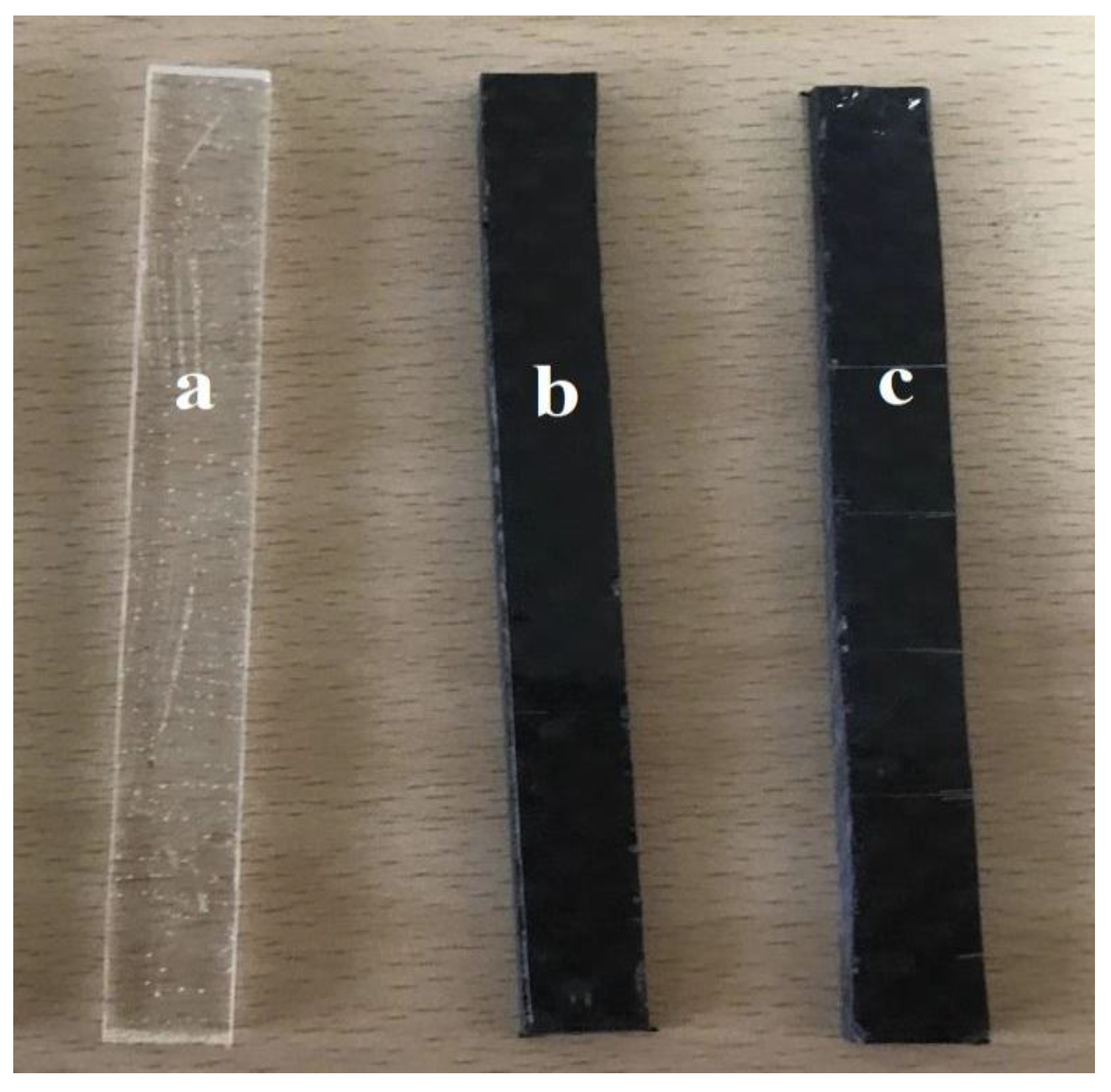
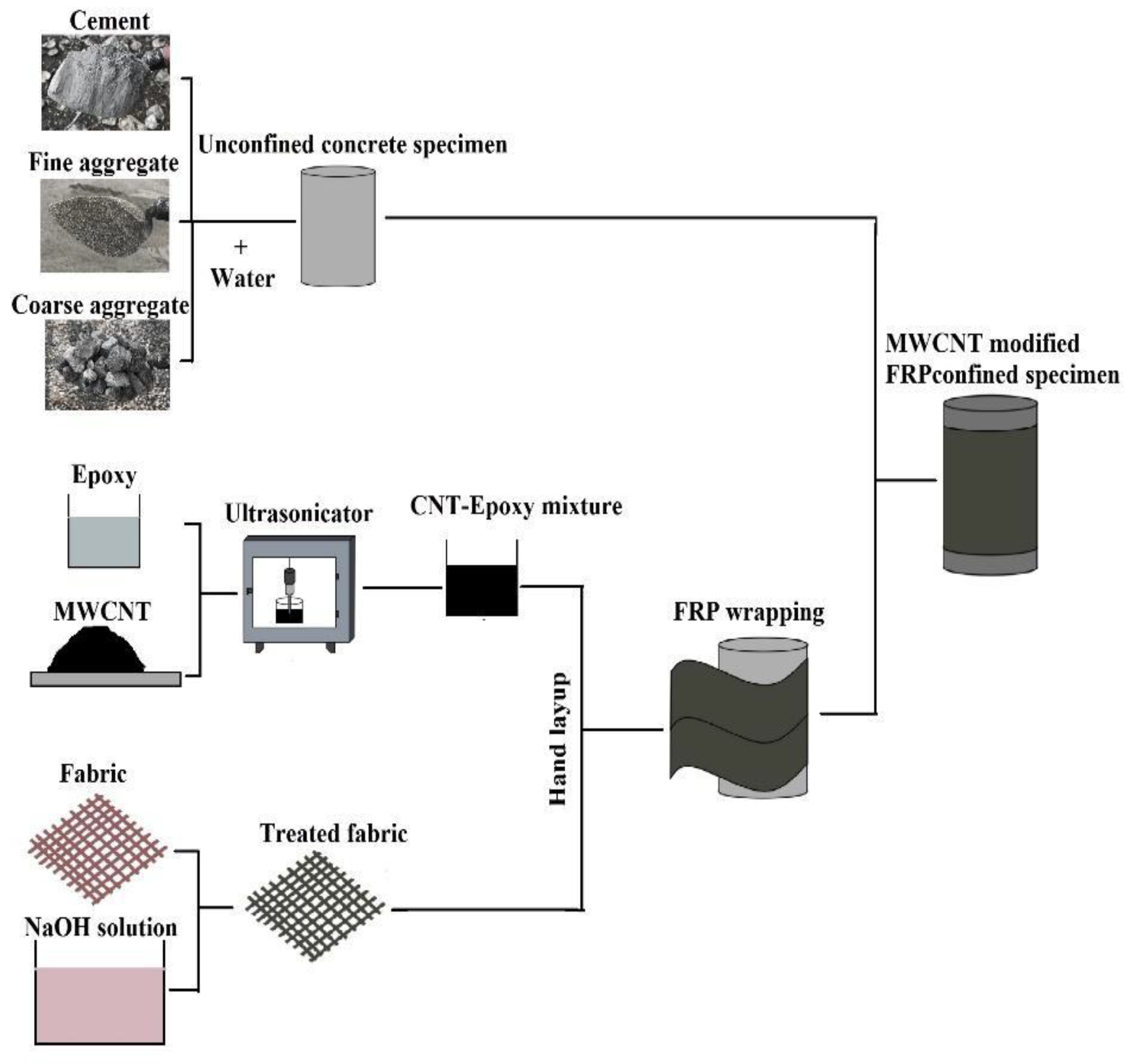

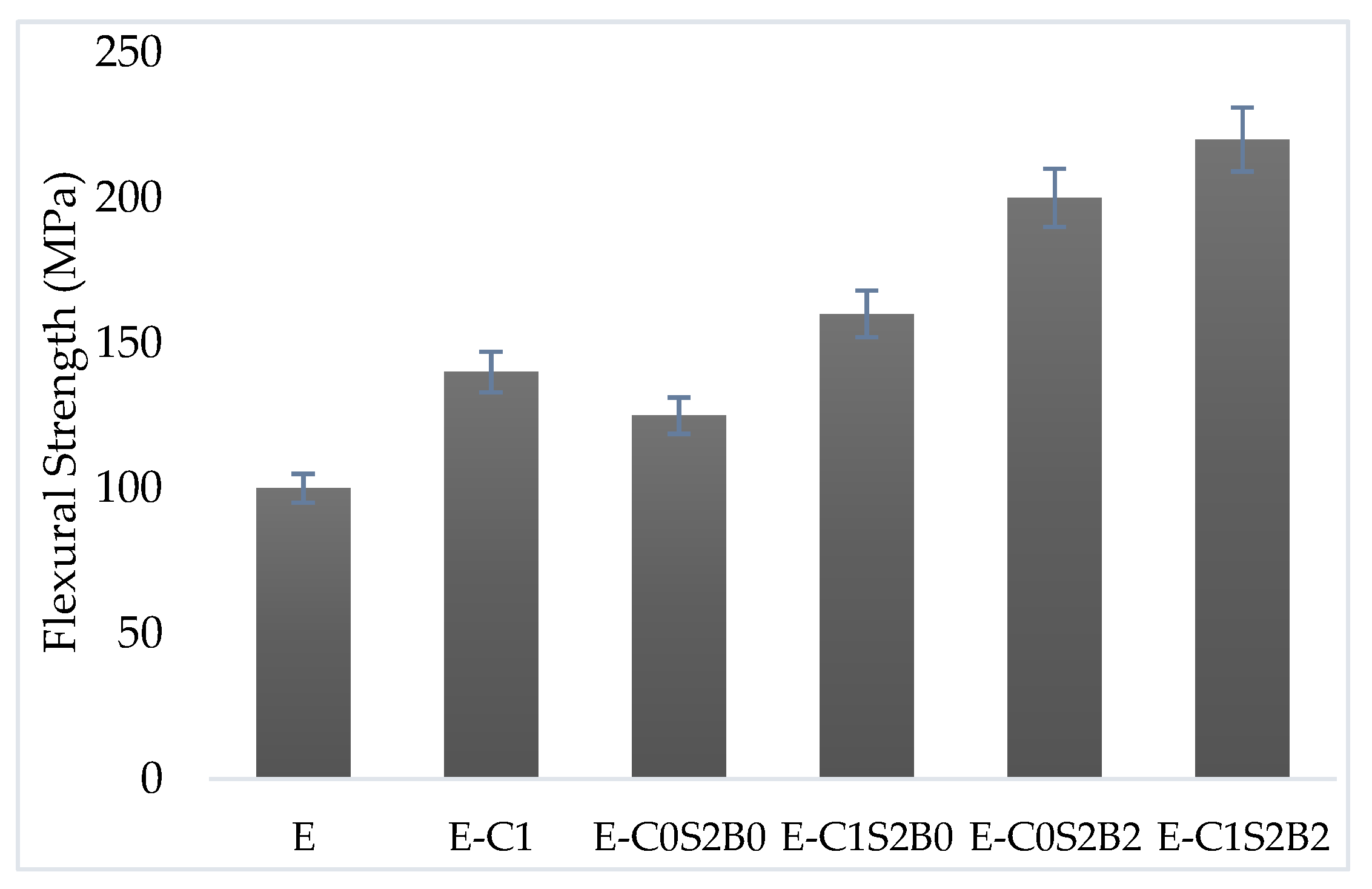
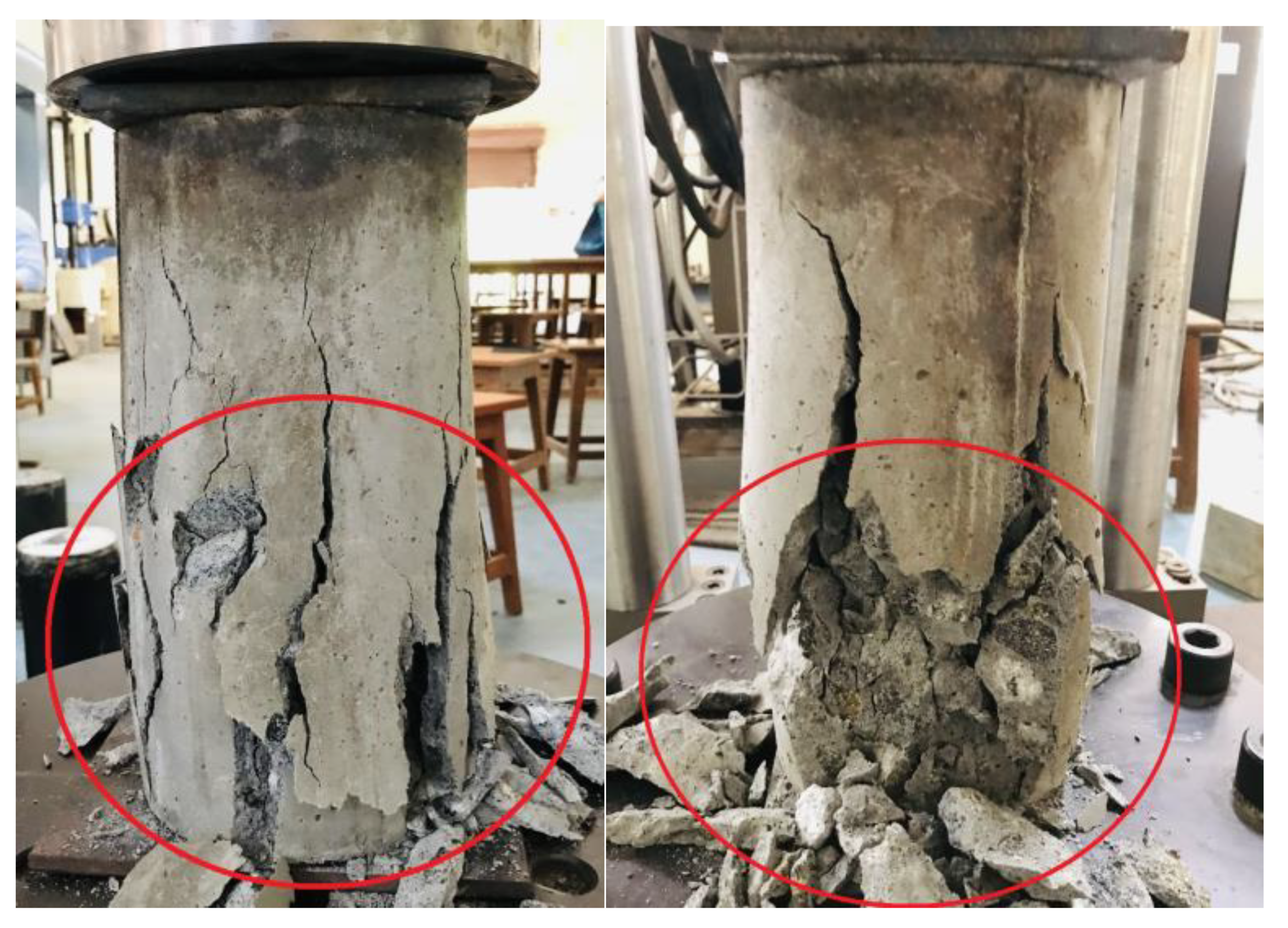
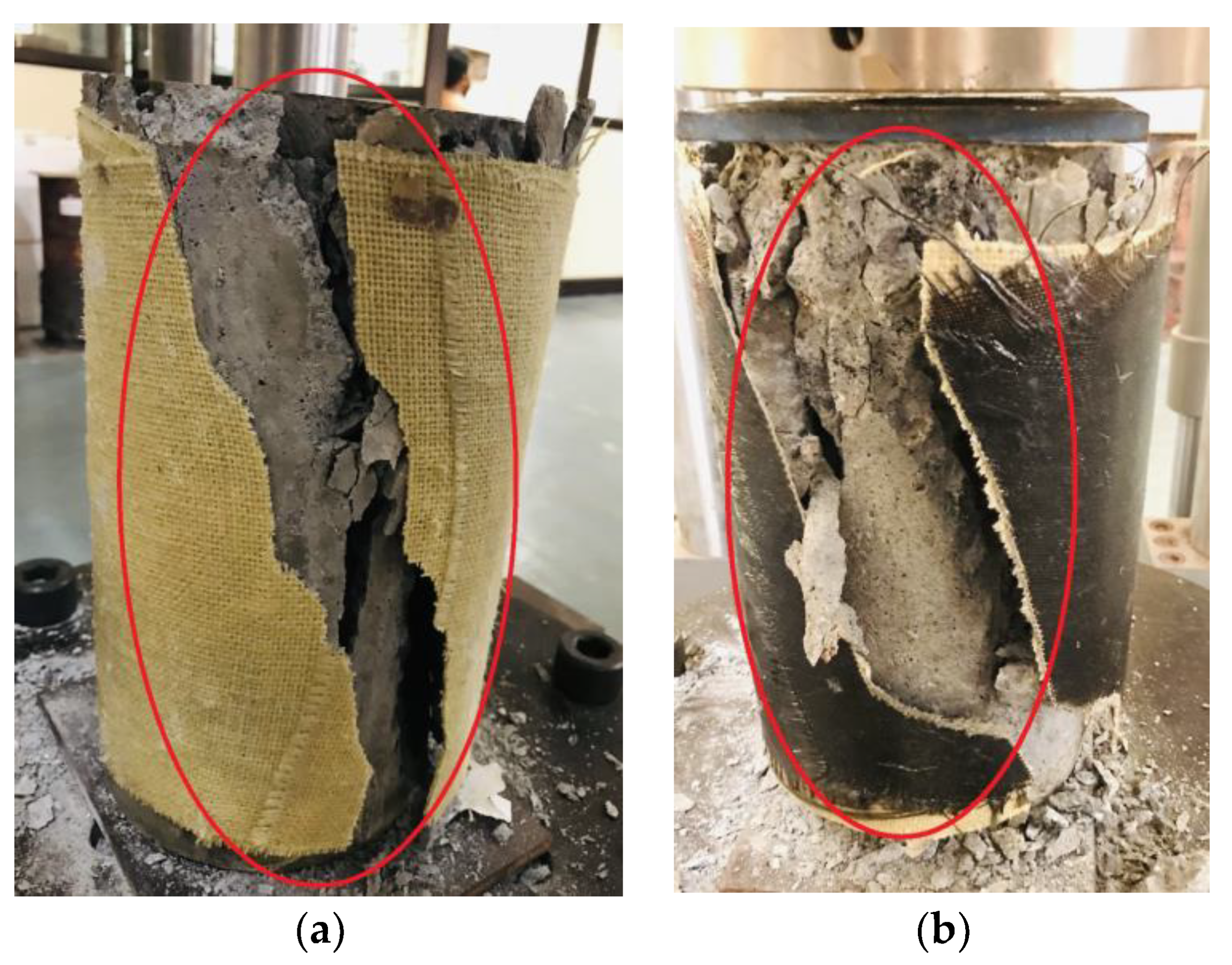
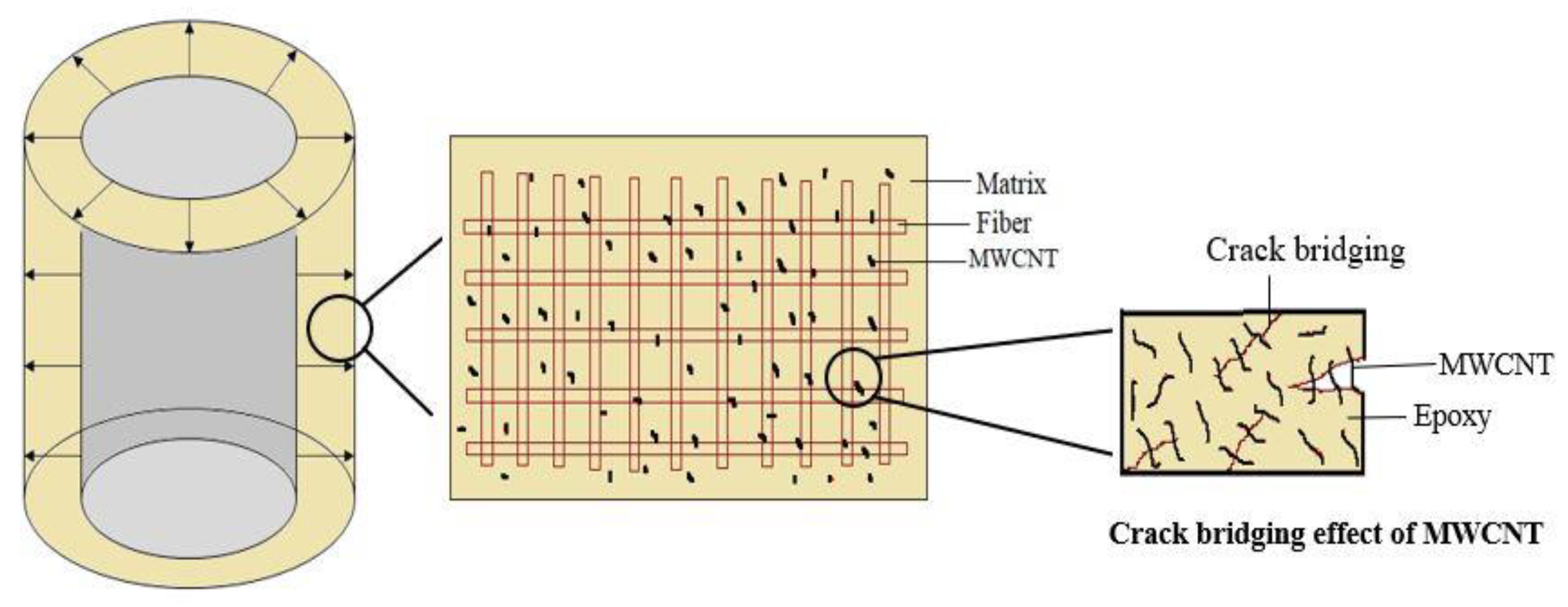
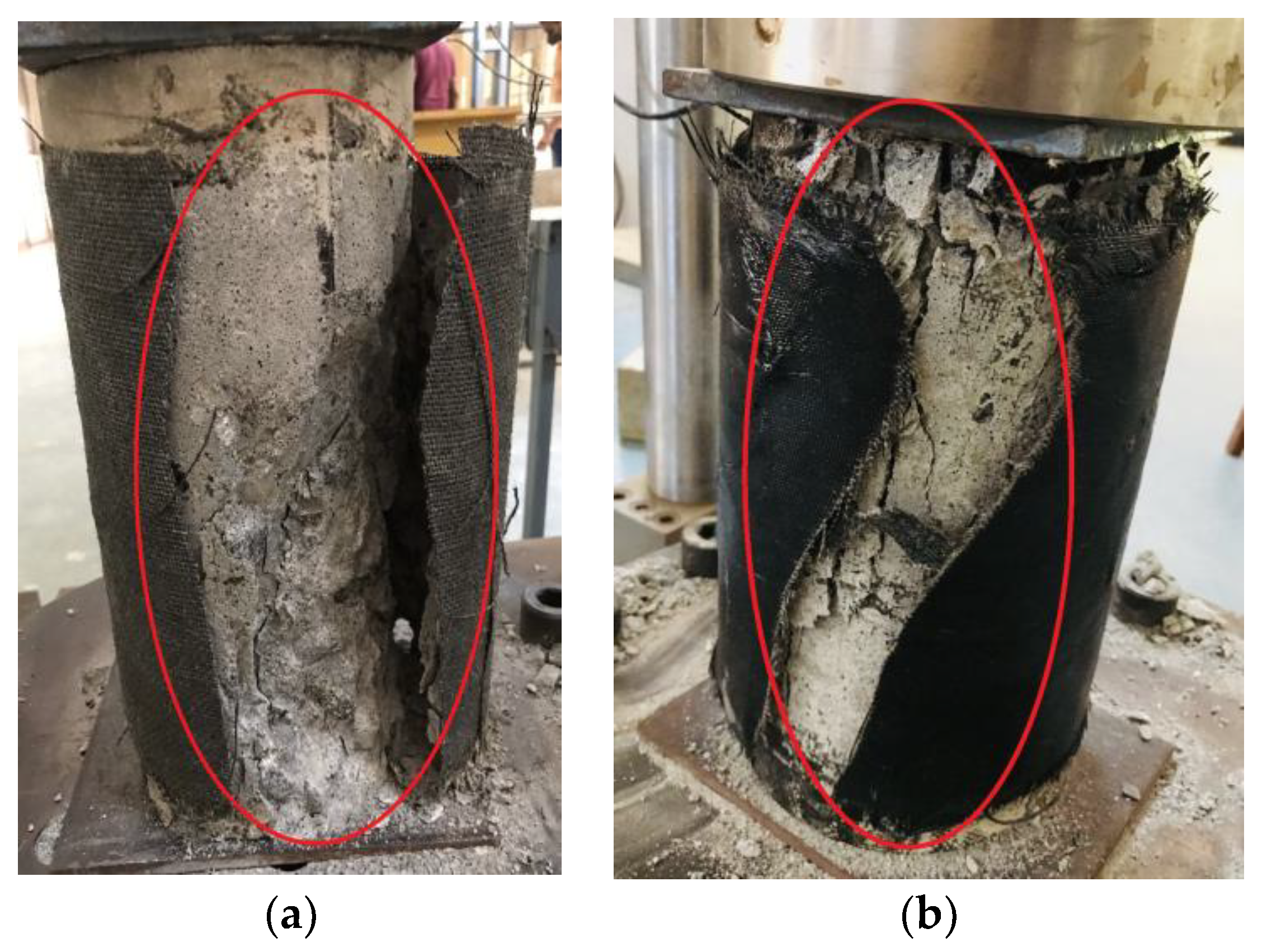


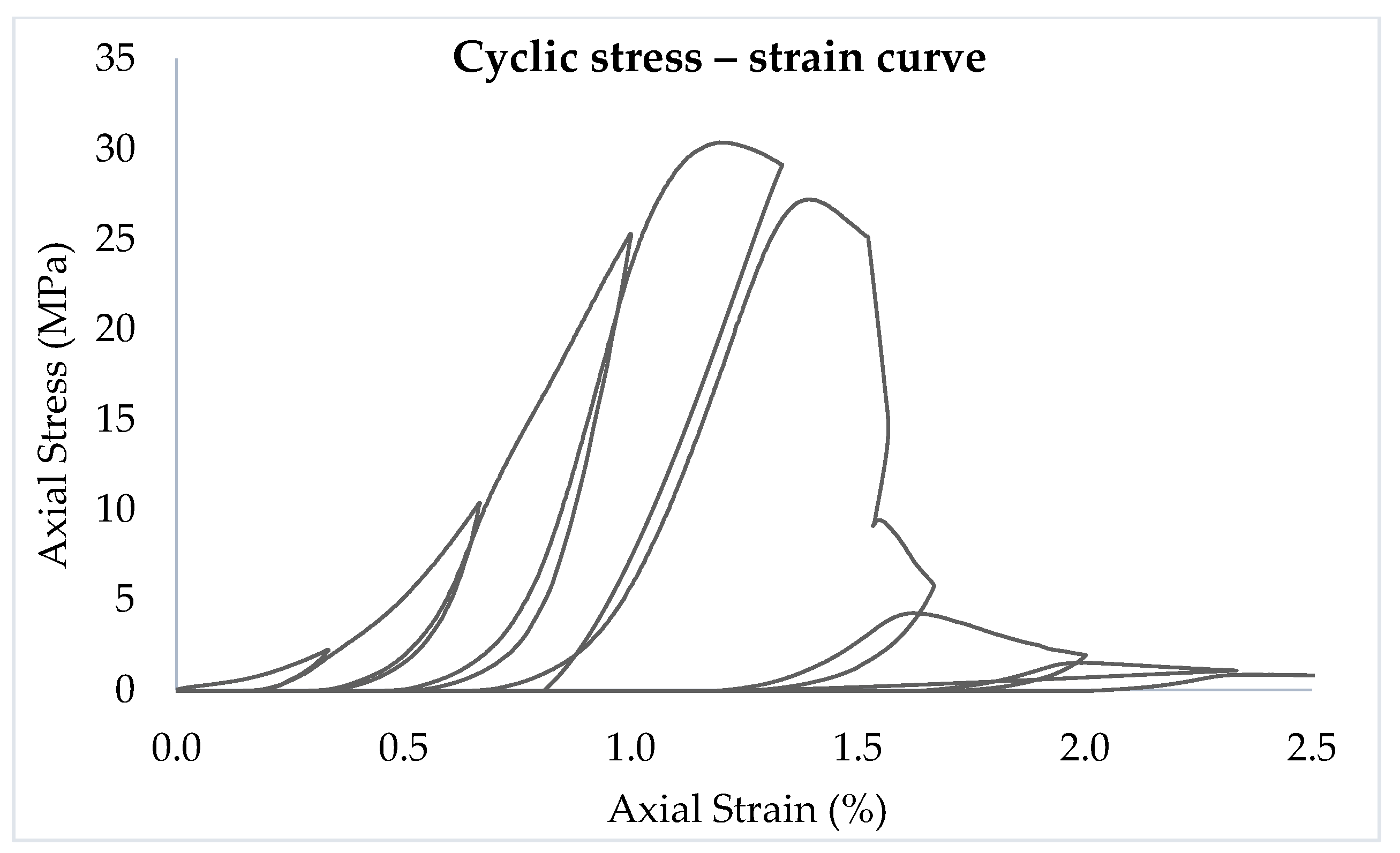



| Material | Property | Value |
|---|---|---|
| Cement | Grade | 53 |
| Specific Gravity | 3.15 | |
| Fine aggregate | Fineness modulus | 2.83 |
| Specific Gravity | 2.63 | |
| Coarse aggregate | Bulk density | 1.52 kg/L |
| Specific gravity | 2.64 | |
| MWCNT | nanotube purity | 97% |
| average length | 2–10 microns | |
| specific surface area | 250–270 m2/g | |
| Sisal fiber | Thickness | 0.8–1.1 mm |
| GSM | 300 | |
| Density | 1582 kg/m3 | |
| Basalt fiber | Thickness | 0.8–1.1 mm |
| GSM | 380 | |
| Density | 2633 kg/m3 |
| Group | Specimen Nomenclature | Specimen Material | MWCNT wt.% in FRP | Sisal Layer Count | Basalt Layer Count | Total No. of Fiber Layers |
|---|---|---|---|---|---|---|
| A | E | Epoxy | 0 | 0 | 0 | 0 |
| E-C1 | Epoxy | 1 | 0 | 0 | 0 | |
| E-C0S2 | Epoxy | 0 | 2 | 0 | 2 | |
| E-C1S2 | Epoxy | 1 | 2 | 0 | 2 | |
| E-C0S2B2 | Epoxy | 0 | 2 | 2 | 4 | |
| E-C1S2B2 | Epoxy | 1 | 2 | 2 | 4 | |
| B | CS | Concrete | 0 | 0 | 0 | 0 |
| C-C0S2 | Concrete | 0 | 2 | 0 | 2 | |
| C-C1S2 | Concrete | 1 | 2 | 0 | 2 | |
| C-C0S2B2 | Concrete | 0 | 2 | 2 | 4 | |
| C-C1S2B2 | Concrete | 1 | 2 | 2 | 4 |
| Specimen | Tensile Strength (MPa) | Young’s Modulus (GPa) | Elongation at Break (%) |
|---|---|---|---|
| E | 36 ± 0.6 | 1.73 ± 0.01 | 6.9 ± 0.9 |
| E-C1 | 61 ± 0.1 | 2.56 ± 0.02 | 10.2 ± 0.1 |
| E-C0S2 | 69 ± 0.8 | 2.88 ± 0.03 | 10.2± 0.2 |
| E-C1S2 | 83 ± 2.0 | 3.18 ± 0.80 | 10.5 ± 0.6 |
| E-C0S2B2 | 72 ± 1.8 | 2.96 ± 0.80 | 10.7 ± 0.8 |
| E-C1S2B2 | 99 ± 2.1 | 3.44 ± 0.90 | 11.3 ± 0.9 |
| Specimen | KIC (MPa·m1/2) | GIC (kJ/m2) |
|---|---|---|
| E | 1.9 ± 0.3 | 1.7 ± 0.4 |
| EC1 | 4.2 ± 0.2 | 6.6 ± 0.2 |
| EC0S2 | 3.5 ± 0.1 | 4.1 ± 0.5 |
| EC0S2B2 | 5.3± 0.6 | 7.4 ± 0.3 |
| EC1S2 | 4.5 ± 0.8 | 5.1 ± 0.7 |
| EC1S2B2 | 6.4 ± 0.8 | 9.8 ± 0.5 |
| Sl No | Specimen | Compressive Strength (MPa) (f’cc or f’co) | Strength Enhancement (%) | Confinement Effectiveness f’cc/f’co | Axial Compressive Strain (%) |
|---|---|---|---|---|---|
| 1 | CS | 17 ± 0.3 | - | - | 0.93 |
| 2 | C-C0S2 | 28 ± 0.6 | 52.14 | 1.521 | 1.27 |
| 3 | C-C1S2 | 29 ± 0.2 | 55.68 | 1.557 | 1.33 |
| 4 | C-C0S2B2 | 31 ± 0.3 | 66.50 | 1.665 | 1.54 |
| 5 | C-C1S2B2 | 32 ± 0.2 | 70.51 | 1.705 | 1.58 |
| Specimen | Confined Compressive Strength fcc (MPa) | Percentage Difference (%) | |
|---|---|---|---|
| Experimental Results | Analytical Results | ||
| C-C0S2 | 28.6 | 28.5 | 0.28 |
| C-C0S2B2 | 31.3 | 31.2 | 0.03 |
| C-C1S2 | 29.2 | 29.3 | 0.36 |
| C-C1S2B2 | 32.2 | 32.1 | 0.31 |
Disclaimer/Publisher’s Note: The statements, opinions and data contained in all publications are solely those of the individual author(s) and contributor(s) and not of MDPI and/or the editor(s). MDPI and/or the editor(s) disclaim responsibility for any injury to people or property resulting from any ideas, methods, instructions or products referred to in the content. |
© 2023 by the authors. Licensee MDPI, Basel, Switzerland. This article is an open access article distributed under the terms and conditions of the Creative Commons Attribution (CC BY) license (https://creativecommons.org/licenses/by/4.0/).
Share and Cite
Joseph, L.; Madhavan, M.K.; Jayanarayanan, K.; Pegoretti, A. Evaluation of Hybrid Fiber Multiscale Polymer Composites for Structural Confinement under Cyclic Axial Compressive Loading. J. Compos. Sci. 2023, 7, 152. https://doi.org/10.3390/jcs7040152
Joseph L, Madhavan MK, Jayanarayanan K, Pegoretti A. Evaluation of Hybrid Fiber Multiscale Polymer Composites for Structural Confinement under Cyclic Axial Compressive Loading. Journal of Composites Science. 2023; 7(4):152. https://doi.org/10.3390/jcs7040152
Chicago/Turabian StyleJoseph, Lakshmi, Mini K. Madhavan, Karingamanna Jayanarayanan, and Alessandro Pegoretti. 2023. "Evaluation of Hybrid Fiber Multiscale Polymer Composites for Structural Confinement under Cyclic Axial Compressive Loading" Journal of Composites Science 7, no. 4: 152. https://doi.org/10.3390/jcs7040152
APA StyleJoseph, L., Madhavan, M. K., Jayanarayanan, K., & Pegoretti, A. (2023). Evaluation of Hybrid Fiber Multiscale Polymer Composites for Structural Confinement under Cyclic Axial Compressive Loading. Journal of Composites Science, 7(4), 152. https://doi.org/10.3390/jcs7040152







